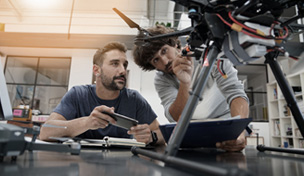Common Questions
Technology Transfer Process
Technology transfer simply refers to the transfer of knowledge and discoveries made during your research to the public domain. CURF engages in formal technology transfer by licensing technology developed at Clemson to industry partners.
CURF typically transfers technology through a formal licensing agreement between CURF and a third-party licensee. We negotiate the best possible terms based upon industry standards and the maturity of the technology. Our primary goal is to execute a longstanding license agreement of 10-15 years or more. For more information, check out our Process of Innovation.
If we believe your technology has market value and we bring it into our technology portfolio, we work to apply for intellectual property protection within 6 months of receiving the disclosure.
However, the transfer process itself can take much longer since it depends on external market drivers and trends. These include: the magnitude of pain realized by an unmet market need a specific technology addresses, the development stage of the technology when disclosed and the development timeline and financial resources required to advance toward a commercial product/service for which customers are willing to pay, regulatory requirements, competing technologies, and the ability to find the appropriate licensing and commercialization partner. Sometimes this process happens simultaneously with the patent process, and sometimes it takes additional months or even several years after the technology is disclosed to our office. Commercialization success is highly dependent on the ability and commitment of a commercialization partner to navigate the multi-faceted risk factors inherent to the technology development process.
The reasons are unique to each researcher and may include:
- Making a positive impact on society
- Achieving recognition and financial rewards
- Generating additional research funding
- Meeting the obligations of a research contract
- Attracting research sponsors
- Creating educational opportunities for students
- Linking students to future job opportunities
Intellectual Property Policy
Intellectual property is a discovery or creation that may be protected under patent, trademark, or copyright laws (see uspto.gov). Intellectual Property includes, but is not limited to, any invention, discovery, creation, know-how, trade-secret, technology, scientific or technological development, mask work, trademark, research data, work of authorship, and computer software. For more information on what constitutes Clemson University intellectual property, see the Clemson University Intellectual Property Policy.
We accept all intellectual property that has been disclosed and determined to be owned by Clemson University. We will work with you to determine if your idea is protectable and identify the appropriate protection—if it has favorable market/return on investment (ROI) potential and is able to attract industry partners.
The Clemson University Intellectual Property policy establishes Clemson’s ownership of IP conceived or developed by the Clemson employees and students. To better understand IP ownership rights, including scholarly works, please consult the Clemson University Intellectual Property Policy.
Disclosure & Evaluation
An invention disclosure is a confidential description of an idea or creative work of art or expression submitted to CURF by the inventor, creator or researcher. The invention disclosure initiates the evaluation process that can lead to protection and commercialization of a technology.
There are several reasons you should disclose to CURF. First, Clemson employees have a duty to disclose per the University IP Policy and the Bayh-Dole Act of 1980 (if your research has been federally funded). Second, having a record of disclosure on file helps support any IP protection sought. Third, CURF has access to a variety of resources to support technology commercialization. We recommend disclosing your invention to our office before publicly disclosing your invention in any other forum.
Public disclosure is any non-confidential disclosure of information. A public disclosure can include anything from a peer-reviewed publication to a campus poster or web announcement. Non-confidential disclosures come up organically during routine academic pursuits such as campus talks, conference abstracts, funded grant applications, seminars, collaborations with faculty at other universities, and open thesis defenses.
When you feel you have developed an idea in the course of research that is novel or solves a significant problem, complete an invention disclosure.
To disclose your invention to CURF, request an Inventor Portal account (if you do not have one) and complete an Invention Disclosure Form using our web-enabled Inventor Portal.
You are encouraged to submit an Invention Disclosure for all inventions and developments that you feel may solve a significant problem and/or have significant value. If you are in doubt, contact CURF to discuss the invention and strategies for commercialization.
Patents & Other Legal Protection
In the U.S., a patent gives the holder the right to exclude others from making, using, selling, offering to sell, and importing the patented invention. A patent does not necessarily provide the holder any affirmative right to practice a technology since it may fall under a broader patent owned by others. Instead, it provides the right to exclude others from practicing the invention. Patent claims are the numbered paragraphs drafted by patent attorneys that provide the legal definition of an inventor's protectable invention.
We have numerous tools and resources to help us assess the patentability, market competition, and commercial potential of your IP. We primarily use patent search and IP analytics software to compile a patent landscape report and begin our determination about whether we should pursue a patent. If we decide to pursue a patent for your idea, we connect you to the best qualified patent attorney in our network to prepare and prosecute your IP. Ultimately, the U.S. Patent Office will determine whether or not your IP is patentable, but we can help you strengthen your idea and connect you to resources that will give you the best chance of success.
Our investment decision is primarily based on our assessment of how successful the technology will be in the marketplace and its potential to realize a return on investment (ROI) over and above the costs to protect the intellectual property. We evaluate market opportunity, relevance to ongoing or future research, and whether or not the technology addresses a significant unmet need in the marketplace. In addition, we take into account how much time and money it will take to commercialize the technology, including regulatory hurdles the technology may have to overcome. For health and life sciences technologies, an assessment of insurance reimburse landscape is also taken into account.
The USPTO is the federal agency, organized under the Department of Commerce, that administers patents on behalf of the government. The USPTO employs patent examiners skilled in all technical fields in order to appraise patent applications. The USPTO also issues federal trademark registrations.
In certain circumstances, U.S. provisional patent applications can provide a tool for preserving patent rights while temporarily reducing costs. This occurs because the application is not examined during the year in which it is pending, and claims are not required. A regular U.S. application and related foreign applications must be filed within one year of the provisional form in order to receive its early filing date. However, an applicant only receives the benefit of the earlier filing date for material that is adequately described and enabled in the provisional application. As a result, the patent attorney often needs your assistance when an application is filed as a "provisional".
Currently, the average U.S. utility patent application is pending for about two years, though inventors in the biotech and computer fields should plan on a longer waiting period. Once a patent is issued, it is enforceable for 20 years from the initial filing of the application that resulted in the patent, assuming that USPTO-mandated maintenance fees are paid.
If you created the invention under a sponsored research or consulting agreement with a company, your CURF representative will need to review that contract to determine ownership and other rights associated with the contract and to determine the appropriate next steps.
Should the technology be jointly owned with another academic institution, your CURF representative will usually enter into an “inter-institutional” agreement that provides for one of the institutions to take the lead in protecting and licensing the invention, sharing of expenses associated with the patenting process, and allocating any licensing revenues. If the technology is jointly owned with another company, your CURF representative will work with the company to determine the appropriate patenting and licensing strategy.
Licensing
A license is a permission that the owner or controller of intellectual property grants to another party, usually under a license agreement.
License agreements describe the rights and responsibilities related to the use and exploitation of intellectual property developed at the University. University license agreements usually stipulate that the licensee should diligently seek to bring the intellectual property into commercial use for the public good and provide a reasonable return to the University.
A licensee is chosen based on its ability to commercialize the technology for the benefit of the general public. Sometimes an established company with experience in similar technologies and markets is the best choice. In other cases, the focus and intensity of a start-up company is a better option. It is rare for the University to have multiple potential licensees bidding on an invention.
Per University policy, a share of any financial return from a license is provided to the inventor(s). Most inventors enjoy the satisfaction of knowing their inventions are being deployed for the benefit of the general public. New and enhanced relationships with businesses are another outcome that can augment one’s teaching, research, and consulting. In some cases, additional sponsored research may result from the licensee.







